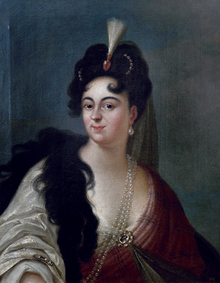- Maria Aurora von Königsmarck
-
Countess Maria Aurora von Königsmarck (sv: Aurora Königsmarck) (28 August 1662 – 16 February 1728) was a Swedish noblewoman of Brandenburg extraction and mistress of Augustus the Strong, Elector of Saxony and King of Poland.
Biography
Aurora was born at Stade, the second child and eldest daughter of Maria Christina von Wrangel and her husband Count Kurt Christoph von Königsmarck, son of Hans Christoff von Königsmarck. Her elder brother, Karl Johann, was a Knight of Malta and a famous adventurer; her two younger siblings were the dilettante artist Amalia Wilhelmina -von Lewenhaupt by marriage- and Philip Christoph, who was the lover of the princess Sophia of Celle, wife of the later King George I of Great Britain.
She spent her childhood in the Agathenburg Castle. When her father died on 1673, her mother Maria Christina took the place of head of the family. From 1677, she began to travel with her family and visit the family properties in Sweden and Germany.
In Sweden, she and her sister Amalia were among the most known participants in the amateur theatre of the royal court, which had the patronage of the queen, Ulrika Eleonora of Denmark. In 1684, Aurora participated in Iphigenie by Jean Racine, which was performed only by women; she played the male part of Agamemnon. This is the first known all female theatre performance in Sweden. She also belonged to the intellectual circle around the Salonist and poet Sophia Elisabet Brenner.
When her mother died (1691), Aurora left Sweden. She and her sister passed some years at Hamburg, where she attracted attention both through her beauty and her talents. In 1694 she went to Dresden, to make inquiries about her brother Philip Christoph of Königsmarck, who had mysteriously disappeared from Hanover. She solicited the help of the Elector Frederick Augustus I to find Philip and, in case he was dead, to resolve any potential inheritance issues.
Shortly after, the Elector made her his first official mistress. On 28 October 1696, in the city of Goslar, she gave birth to a son, Maurice, who later became the famous marshal de Saxe.
However, the Elector quickly tired of Aurora, who then spent her time trying to secure the position of princess-abbess of the Quedlinburg Abbey, an office which carried with it princely dignity as imperial estate of the Holy Roman Empire, and to recover the lost inheritance of her family in Sweden. In January 1698 she was made coadjutor abbess and two years later (1700) provostess (German: Pröpstin) of the Abbey, but lived mainly in Berlin, Dresden and Hamburg. She was replaced as mistress by her own companion, Maria Aurora of Spiegel.
In 1702 she went on a diplomatic errand to Charles XII of Sweden in his winter camp in Courland on behalf of Augustus, but her adventurous journey ended in failure. The countess, who was described by Voltaire as "the most famous woman of two centuries", died at Quedlinburg, aged sixty-five. Her namesake and great-great-granddaughter, Aurore Dupin, became the French novelist George Sand.
References
- Voltaire, Histoire de Charles XII, Œuvres complètes, Tome XXII, Paris 1821. 89-90 pp.
- F. Cramer, Denkwürdigkeiten der Gräfin M. A. Königsmark (Leipzig, 1836); and Biographische Nachrichten van der Gräfin M. A. Königsmark (Quedlinburg, 1833)
- W. F. Palmblad, Aurora Königsmark und ihre Verwandte (Leipzig, 1848-1853)
- C. L. de Pollnitz, La Saxe galante (Amsterdam, 1734)
- O. J. B. von Corvin-Wiersbitzki, Maria Aurora, Gräfin von Königsmark (Rudolstadt, 1902).
- Lars Löfgren, Svensk teater (Swedish theatre), Stockholm, Natur och Kultur (2003) ISBN 91-27-09672-6
- Nina Burton: Den nya kvinnostaden. Pionjärer och glömda kvinnor under tvåtusen år (The new city of women. Pioneers and forgotten women during two thousand years), (Uddevalla, 2005)
 This article incorporates text from a publication now in the public domain: Chisholm, Hugh, ed (1911). Encyclopædia Britannica (11th ed.). Cambridge University Press.Categories:
This article incorporates text from a publication now in the public domain: Chisholm, Hugh, ed (1911). Encyclopædia Britannica (11th ed.). Cambridge University Press.Categories:- Mistresses of German royalty
- Mistresses of Polish royalty
- Swedish nobility
- Swedish people of German descent
- 1662 births
- 1728 deaths
- 17th-century Swedish people
- Members of Christian religious orders
- People of the Great Northern War
Wikimedia Foundation. 2010.

